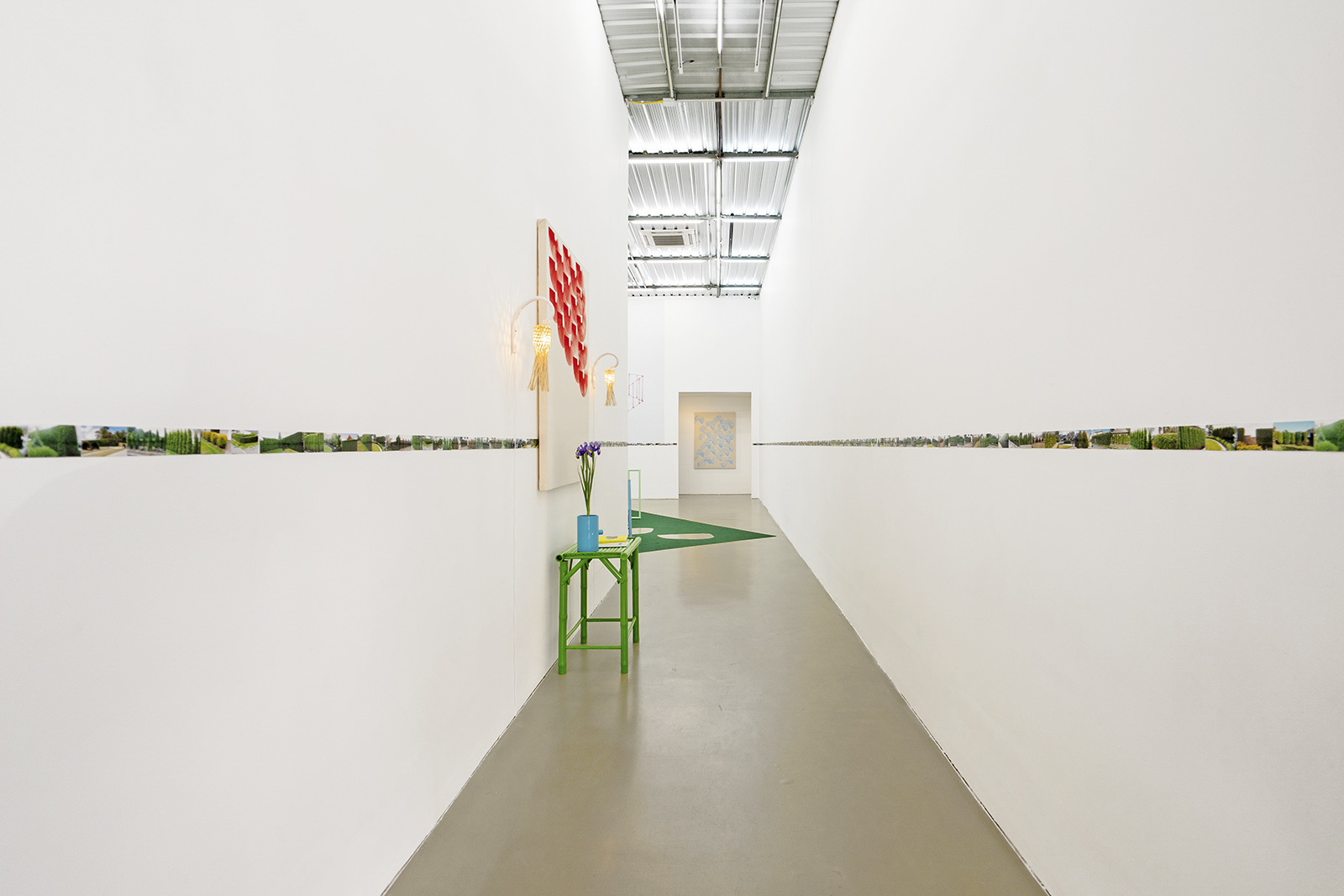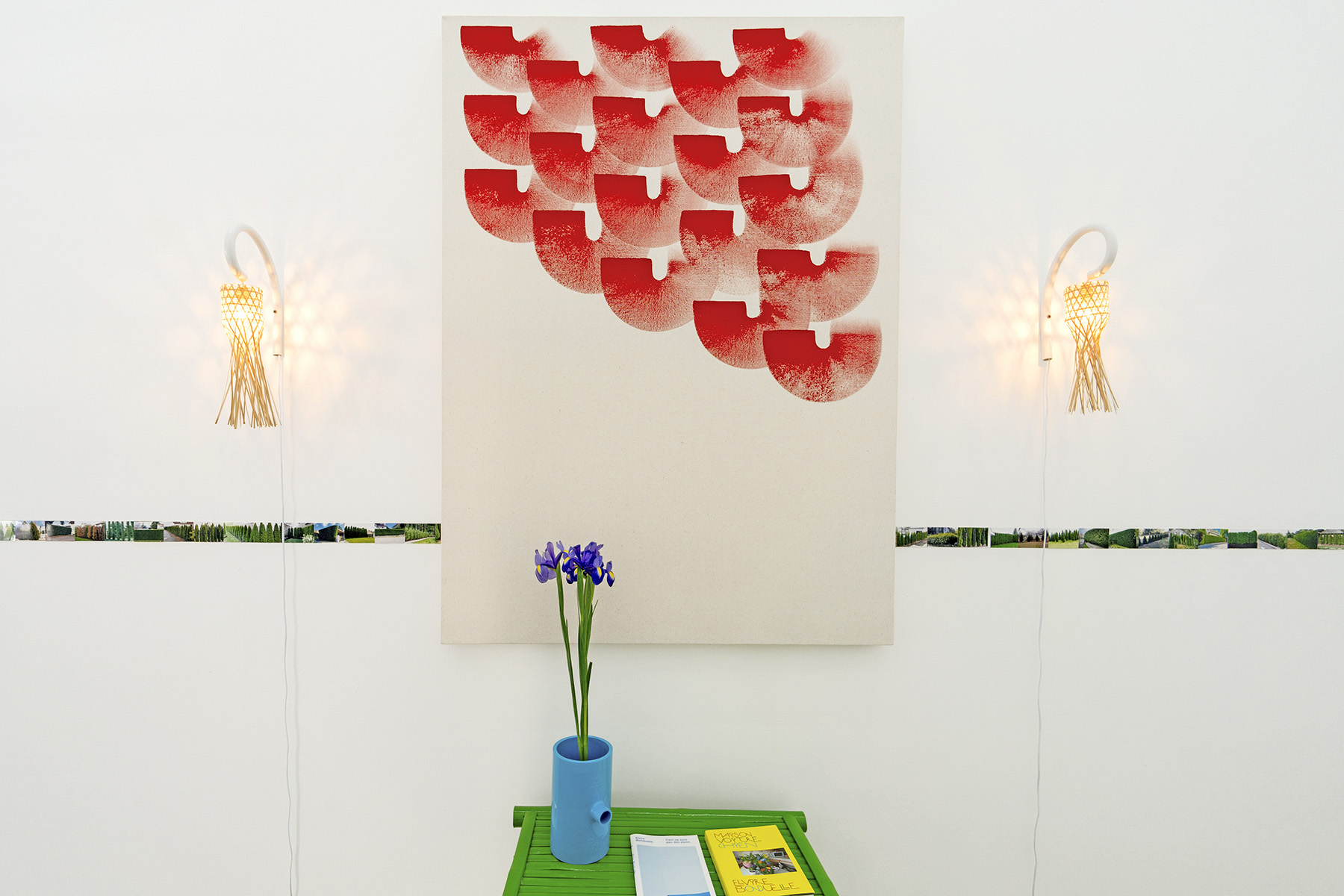Vacances Mécaniques
Remerciements à Rirkrit Tiravanija et l'ambassade française en Thaïlande
-

-

-

Privacy tree frieze, c-print on glossy paper, 5x7cm each, various lenghts
-

-

-

-

Crowd control, painted metal, 2 x 7M long, H85cm, with the help of the French Embassy in Thailand
-

-

Maison Voiture Chien Fleurs, memory card game, 100 images, 5 x 7 cm double face c-print on glossy paper, 2019
-

-

Three Trees, rotating paintings, 110 x 150 cm, acrylic on canvas
-

-

-

-

-

-

-

-

Fire Foutain, PVC pipes, water pump, aluminium tray, pebbles and bucket
-

Human cushion, 170 x 50 cm, fabric and polyesther padding
-

-

A table, four chairs, a perfect lawn and fences. At first glance, Elvire Bonduelle’s solo exhibition - Vacances Mécaniques or วันหยุดซ่อนกล - evokes the plasticised domesticity of a suburban residence, more so perhaps than exotic locations the idea of a holiday might conjure. Yet such thought is rapidly set aside, as we are led through a colourful terrace and dared to rethink our collective understanding of breaks, long weekends and annual leaves.
With playful invitations to either interact with / resist / be piloted by her curve-shaped works - rollicking tweaks on domestic bliss or your idea of a picture-perfect destination - Bonduelle writes off an enduring prejudice. Too often, we are led to believe that going out (-side) demonstrates qualities such as an open mind or adventurous spirit; whereas staying in (-side) has the less stellar reputation of being somewhat stifling, boringly conventional and a sign or laziness. Just as authors, from Ivan Gontcharov to Swiss essayist Mona Chollet, sought to rehabilitate the unfairly disparaged homebodies, Elvire Bonduelle teases at the equally gregarious nature of holiday-goers - many of whom, each year, unpack their suitcases or lay down their beach towels in the same spot.
The sacrosanct annual leave as a routine or ritual provides a departure point for the exhibition. It was artfully surveyed in Agnès Varda’s Du Côté de la Côte (1958), in which the filmmaker looks at the tidal inflow and outflow of tourists on the French Riviera and features centrally in Eric Rohmer’s The Green Ray (1986). In the latter, the summer holiday isn’t simply a backdrop or plot-moving device but almost a character: an antagonist to the heroine, who sheepishly seeks out different holiday options - the beach, the mountain, the countryside - as one would try on different outfits.
Elvire Bonduelle’s installations and sculptures suggest, if not trigger, movement, and so do the holiday breaks promising an escape from daily life and the clutter of one’s home. But to journey across her works is to encounter repetitions and replications, organic in their creation - from her choice to use unprimed canvases to the artisan-made metallic structures - yet tending towards the mechanical, clockwork arrangement of life, work, rest and happiness. Disarmingly effortless (or appearing so), the pathways and motifs she initiates are half-provocations, half-injunctions; each time compelling us to either conform with or break away from the social norms hinted at.
To flaunt and to conceal. These two imperatives are kept in tension by the artist who, using minimal strokes, paints an arborescent landscape - or is it a hedge, a delimitation of one’s private retreat, jealously guarded? The trees, the fences, the photographic frieze running along the walls encircle the gallery space, transforming it into an individual cell. A habitat fit for a nuclear family - the ideology of which is then blown out of proportion and advertised on a billboard-like print.
Things, Georges Perec’s fictional study of 1960s yuppiedom saw its protagonists - a young French couple - grapple with such idealised happiness, primarily tied to an insatiable consumption. Yet the novel also looked at their attempt to escape this model, prefiguring the collapse of interior / exterior dichotomies. In our era, the minimalism once associated with time away from home (think of writer Joan Didion’s essential packing list) has made its way back into households through decluttering, while getaways are now as neatly curated as a vase and a book strategically placed on a coffee table once were. Whether at home or on a retreat, attributes denoting happiness are sorted into as many hashtags as one can think of. But if in doubt, it’s safe to start with a #house #car and #dog.
Ariane Kupferman-Kutthavong